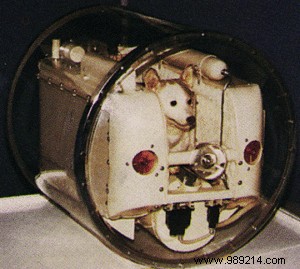If we remember Laïka as the first mammal in history to have left Earth for space, the fate of the animal remains unfamiliar to the general public. Yet the tragic fate of the dog sadly illustrates the commonplace sacrifice of the animal world for scientific advances. His death is also anchored in the context of the Cold War where Americans and Soviets clashed for space supremacy. Designated as a volunteer for a one-way trip among the stars, Laïka found herself at the disastrous intersection of these historical and scientific issues.
On October 4, 1957, the USSR launched Sputnik 1, the first satellite in the history of mankind, into orbit. This resounding success gave an idea to Nikita Khrushchev, the Soviet leader at the time. Indeed, he judged that the 40th anniversary of the Russian revolution scheduled for a month later, on November 7, 1957, would be the perfect opportunity for a new space exploit. In addition, the launch would make it possible to affirm a little more the superiority of the USSR over the United States in this matter. The First Secretary of the Communist Party then instructed the teams of the Soviet space program to set up a mission in record time. If placing a human being in orbit seemed too ambitious given the short month of preparation that remained,sending a dog in space seemed much more possible.
To carry out the mission, the teams of the Soviet space program selected three stray dogs found in Moscow. Only females are chosen, because they do not raise their paws to urinate. Compared to males, they therefore require less space in the cockpit. For the three candidates, began a period of testing and training as intense as they were cruel. They were placed in centrifuges and in increasingly small cages in order to accustom them to the cramped space of the cabin, for example.
Of the three, the Soviets chose the quietest female dog, Laika (meaning little barker in Russian) for space travel. She was equipped with a spacesuit specially designed for the occasion. This equipment consisted in particular of straps to keep her attached and sensors to follow her vital signs. Regarding the trip, the engineers prepared food consisting of a mixture of collagen, bread and fat. Finally, on October 31, 1957, Laïka took her place in the cockpit of Sputnik 2 and she had to wait there until November 3 so that all the conditions are met for the launch. During all this time, the animal therefore remained a prisoner of the capsule...
During takeoff, Laïka's heart rate went from a hundred beats per minute to more than two hundred and forty! Once in orbit, the animal took a good three hours to calm down. Two hours later, however, Laïka gave no more signs of life. The heat and dehydration had killed him. And even if she had survived in space, nothing was planned to ensure her safe return to Earth . Thus on April 14, 1958, Sputnik 2 finally disintegrated during its entry into the atmosphere with the remains of Laïka on board.

The Soviet authorities were delighted to announce the success of the launch, but were careful not to inform the public of Laika's death. They even sent press releases as reassuring as they were misleading to the journalists of the time. However, unable to evade the death of the dog forever, the Soviets end up tinkering with a final lie to save appearances: The engineers would have poisoned Laïka's food to prevent the dog from suffering in space. In 2002, however, the truth came out when a scientist who participated in the mission confessed to the horrific reasons behind the dog's death.
For their part, animal life protection organizations at the time did not sit idly by. For example, the English organization Dogs Trust invited all dog owners to observe a daily minute of silence throughout the Sputnik 2 mission. In France, the SPA sent a protest letter to the USSR embassy to denounce the sacrifice of an innocent life in the name of science and space competition between Soviets and Americans.